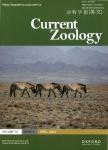Consistent differences in foraging behavior in 2 sympatric harvester ant species may facilitate coexistence
Consistent differences in foraging behavior in 2 sympatric harvester ant species may facilitate coexistence作者机构:Department of Zoology Faculty of Life Sciences Tel Aviv University Tel Aviv 69978 Israel and bDepartment of Ecology Evolution Marine Biology University of California Santa Barbara CA USA
出 版 物:《Current Zoology》 (动物学报(英文版))
年 卷 期:2018年第64卷第5期
页 面:653-661页
核心收录:
学科分类:0710[理学-生物学] 07[理学] 0905[农学-畜牧学] 0906[农学-兽医学] 09[农学]
基 金:funded by a start-up grant of the US-Israel Binational Science Foundation by the Israel Science Foundation
主 题:behavioral consistency coexistence mechanisms foraging harvester ants plant-ant interactions.
摘 要:The co-occurrence of 2 similar species depends on their ability to occupy different ecological niches. Here, we compared the consistency of different aspects of foraging behavior in 2 cooccurring harvester ant species (Messor ebeninus and Messor arenarius), under field conditions. The 2 species are active concomitantly and display a similar diet, but M. arenarius features smaller colonies, larger workers on average, and a broader range of foraging strategies than M. ebeninus. We characterized the flora in the 2 species' natural habitat, and detected a nesting preference by M. arenarius for more open, vegetation-free microhabitats than those preferred by M. ebeninus. Next, we tested the food preference of foraging colonies by presenting 3 non-native seed types. Messor arenarius was more selective in its food choice. Colonies were then offered 1 type of seeds over 3 days in different spatial arrangements from the nest entrance (e.g., a seed plate close to the nest entrance, a seed plate blocked by an obstacle, or 3 plates placed at increasing distances from the nest entrance). While both species were consistent in their foraging behavior, expressed as seed collection, under different treatments over time, M. ebeninus was more consistent than M. arenarius. These differences between the species may be expxained by their different colony size, worker size, and range of foraging strategies, among other factors. We suggest that the differences in foraging, such as in food preference and behavioral consistency while foraging, could contribute to the co-occurrence of these 2 species in a similar habitat.



